|
This Site:
Discovery of America
The Explorers
Post Columbian Exploration
Thirteen Original Colonies
Colonization of America
Colonial Life
Colonial Days and Ways
Independence Movement
The Patriots
Prelude to War
Revolutionary War
Revolutionary War Battles
Overview of Revolutionary War
Revolutionary War
Timeline
Civil War
American Flag
Mexican War
Republic of Texas
Indians
|
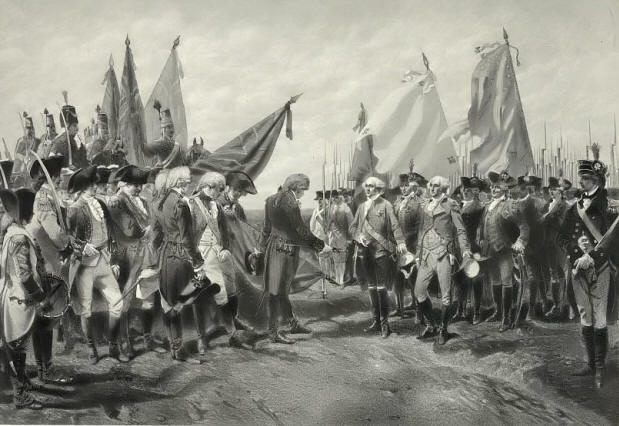
Cornwallis Surrender at Yorktown
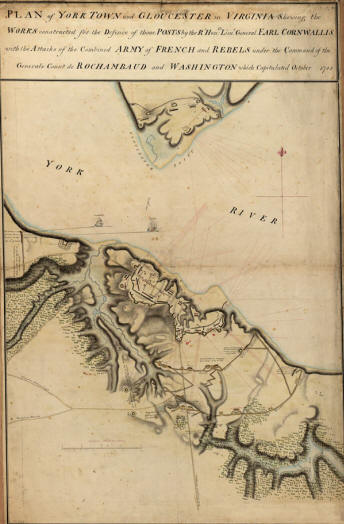 Yorktown,
SIEGE OF. The allied armies joined
Lafayette at
Williamsburg, Virginia,
September 25, 1781, and on the 27th there was a besieging army there
of 16,000 men, under the chief command of
George Washington,
assisted by Rochambeau.
The British force, about half as numerous, were mostly behind
entrenchments at Yorktown. On the arrival of Washington and
Rochambeau at Williamsburg they proceeded to the Ville de Paris, De
Grasse's flagship, to congratulate the admiral on his victory over
Graves on the 5th, and to make specific arrangements for the future.
Preparations for the siege were immediately begun. The allied armies
marched from Williamsburg (September 28), driving in the British
outposts as they approached Yorktown, and taking possession of
abandoned works. The allies formed a semicircular line about 2 miles
from the British entrenchments, each wing resting on the York River,
and on the 30th the place was completely invested. The British at
Gloucester, opposite, were imprisoned by French dragoons under the
Duke de Lauzun, Virginia militia, led by General Weedon, and 800
French marines. Only once did the imprisoned troops attempt to
escape from that point.
Tarleton's legion sallied out, but were soon driven back by
Lauzun's cavalry, who made Tarleton's horse a prisoner and came near
capturing his owner. In the besieging lines before Yorktown the
French troops occupied the left, the West India troops of St. Simon
being on the extreme flank. The Americans were on the right; and the
French artillery, with the quarters of the two commanders, occupied
the centre. The American artillery, commanded by
General Knox, was
with the right. The fleet of De Grasse was in Lynn Haven Bay to beat
off any vessels that might attempt to relieve
Cornwallis. On the
night of October 6 a heavy ordnance was brought up from the French
ships, and trenches were begun at 600 yards from the British works.
The first parallel was completed before the morning of the 7th,
under the direction of General Lincoln; and on the afternoon of the
9th several batteries and redoubts were finished, and a general
discharge of heavy guns was opened by the Americans on the right.
Early on the morning of the 10th the French opened several batteries
on the left. That evening the same troops hurled red-hot balls upon
British vessels in the river, which caused the destruction by fire
of several of them—one a 44-gun ship. Yorktown,
SIEGE OF. The allied armies joined
Lafayette at
Williamsburg, Virginia,
September 25, 1781, and on the 27th there was a besieging army there
of 16,000 men, under the chief command of
George Washington,
assisted by Rochambeau.
The British force, about half as numerous, were mostly behind
entrenchments at Yorktown. On the arrival of Washington and
Rochambeau at Williamsburg they proceeded to the Ville de Paris, De
Grasse's flagship, to congratulate the admiral on his victory over
Graves on the 5th, and to make specific arrangements for the future.
Preparations for the siege were immediately begun. The allied armies
marched from Williamsburg (September 28), driving in the British
outposts as they approached Yorktown, and taking possession of
abandoned works. The allies formed a semicircular line about 2 miles
from the British entrenchments, each wing resting on the York River,
and on the 30th the place was completely invested. The British at
Gloucester, opposite, were imprisoned by French dragoons under the
Duke de Lauzun, Virginia militia, led by General Weedon, and 800
French marines. Only once did the imprisoned troops attempt to
escape from that point.
Tarleton's legion sallied out, but were soon driven back by
Lauzun's cavalry, who made Tarleton's horse a prisoner and came near
capturing his owner. In the besieging lines before Yorktown the
French troops occupied the left, the West India troops of St. Simon
being on the extreme flank. The Americans were on the right; and the
French artillery, with the quarters of the two commanders, occupied
the centre. The American artillery, commanded by
General Knox, was
with the right. The fleet of De Grasse was in Lynn Haven Bay to beat
off any vessels that might attempt to relieve
Cornwallis. On the
night of October 6 a heavy ordnance was brought up from the French
ships, and trenches were begun at 600 yards from the British works.
The first parallel was completed before the morning of the 7th,
under the direction of General Lincoln; and on the afternoon of the
9th several batteries and redoubts were finished, and a general
discharge of heavy guns was opened by the Americans on the right.
Early on the morning of the 10th the French opened several batteries
on the left. That evening the same troops hurled red-hot balls upon
British vessels in the river, which caused the destruction by fire
of several of them—one a 44-gun ship.
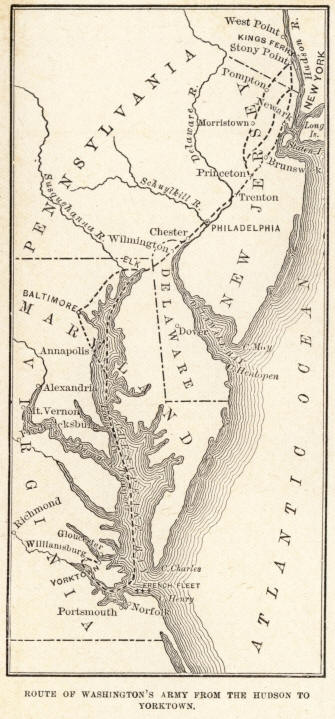 The allies began the second parallel on the night of the 11th, which
the British did not discover until daylight came, when they brought
several heavy guns to bear upon the diggers. On the 14th it was
determined to storm two of the redoubts which were most annoying,
as they commanded the trenches. One on the right, near the York
River, was garrisoned by forty-five men; the other, on the left,
was manned by about 120 men. The capture of the former was entrusted
to Americans led by Lieutenant-Colonel Alexander Hamilton, and that
of the latter to Freneh grenadiers led by Count Deuxponts. At a
given signal Hamilton advanced in two columns—one led by Major Fish,
the other by Lieutenant-Colonel Gimat, Lafayette's aide; while
Lieutenant-Colonel John Laurens, with eighty men, proceeded to turn
the redoubt to intercept a retreat of the garrison. So agile and
furious was the assault that the redoubt was carried in a few
minutes, with little loss on either side.
Laurens was among the
first to enter the redoubt, and make the commander, Major Campbell,
a prisoner. The life of every man who ceased to resist was spared.
Meanwhile the French, after a severe struggle, in which they lost
about 100 men in killed and wounded, captured the other redoubt.
Washington, with Knox and some others, had watched the movements
with intense anxiety, and when the commander-in-chief saw both
redoubts in possession of his troops he turned and said to Knox,
"The work is done, and well done." That night both redoubts were
included in the second parallel. The situation of Cornwallis was now
critical. He was surrounded by a superior force. his works were
crumbling, and he saw that when the second parallel of the besiegers
should be completed and the cannon on their batteries mounted his
post at Yorktown would become untenable, and he resolved to attempt
an escape by abandoning the place, his baggage, and his sick, cross
the York River, disperse the allies who environed Gloucester, and by
rapid marches gain the forks of the Rappahannock and Potomac, and,
forcing his way by weight of numbers through
Maryland and
Pennsylvania, join
Clinton at
New York. The allies began the second parallel on the night of the 11th, which
the British did not discover until daylight came, when they brought
several heavy guns to bear upon the diggers. On the 14th it was
determined to storm two of the redoubts which were most annoying,
as they commanded the trenches. One on the right, near the York
River, was garrisoned by forty-five men; the other, on the left,
was manned by about 120 men. The capture of the former was entrusted
to Americans led by Lieutenant-Colonel Alexander Hamilton, and that
of the latter to Freneh grenadiers led by Count Deuxponts. At a
given signal Hamilton advanced in two columns—one led by Major Fish,
the other by Lieutenant-Colonel Gimat, Lafayette's aide; while
Lieutenant-Colonel John Laurens, with eighty men, proceeded to turn
the redoubt to intercept a retreat of the garrison. So agile and
furious was the assault that the redoubt was carried in a few
minutes, with little loss on either side.
Laurens was among the
first to enter the redoubt, and make the commander, Major Campbell,
a prisoner. The life of every man who ceased to resist was spared.
Meanwhile the French, after a severe struggle, in which they lost
about 100 men in killed and wounded, captured the other redoubt.
Washington, with Knox and some others, had watched the movements
with intense anxiety, and when the commander-in-chief saw both
redoubts in possession of his troops he turned and said to Knox,
"The work is done, and well done." That night both redoubts were
included in the second parallel. The situation of Cornwallis was now
critical. He was surrounded by a superior force. his works were
crumbling, and he saw that when the second parallel of the besiegers
should be completed and the cannon on their batteries mounted his
post at Yorktown would become untenable, and he resolved to attempt
an escape by abandoning the place, his baggage, and his sick, cross
the York River, disperse the allies who environed Gloucester, and by
rapid marches gain the forks of the Rappahannock and Potomac, and,
forcing his way by weight of numbers through
Maryland and
Pennsylvania, join
Clinton at
New York.
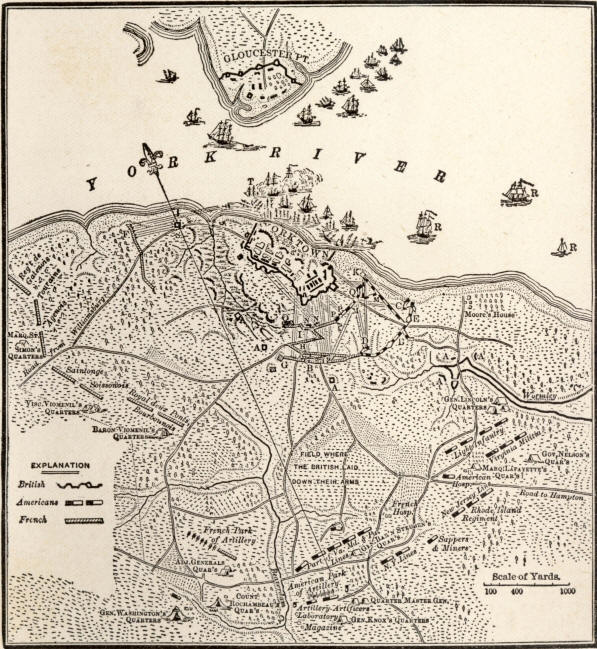
Plan for the Siege of Yorktown
Boats for the passage of the river were prepared and a part of the
troops passed over, when a furious storm suddenly arose and made any
further attempts to cross too hazardous to be undertaken. The troops
were brought back, and the earl lost hope. After that the
bombardment of his lines was continuous, severe, and destructive,
and on the 17th he offered to make terms for surrender. On the
following day Lieutenant-Colonel Laurens and Viscount de Noailles (a
kinsman of Madame Lafayette), as commissioners of the allies, met
Lieutenant-Colonel Dundas and Major Ross, of the British army, at
the house of the Widow Moore to arrange terms for capitulation. They
were made similar to those demanded of Lincoln at
Charleston
eighteen months before (See
Yorktown Articles of
Capitulation). The capitulation was duly signed, October 19,
1781, and late on the afternoon of the same day Cornwallis, his
army, and public property were surrendered to the allies.
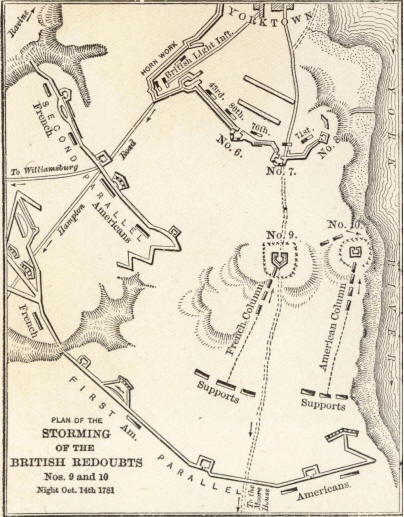 The delivery of the colors of the several British regiments at
Yorktown, twenty-eight in number, was performed in this wise:
twenty-eight British captains, each bearing a flag in a case, were
drawn up in line. Opposite to these were twenty-eight American
sergeants in a line to receive them. Colonel Hamilton, who had the
direction of the movement, appointed an ensign to conduct the
ceremony. When that officer gave the order for the British captains
to advance two paces and deliver up their colors, and the American
sergeants to advance two paces to receive them, the former
hesitated, and gave as a reason that they were unwilling to
surrender their flags to noncommissioned officers. Hamilton, who
was at a distance, observed the hesitation, and rode up to inquire
the cause. On being informed, he willingly spared the feelings of
the vanquished captains, and ordered the ensign to receive them
himself and then deliver them to the sergeants. The delivery of the colors of the several British regiments at
Yorktown, twenty-eight in number, was performed in this wise:
twenty-eight British captains, each bearing a flag in a case, were
drawn up in line. Opposite to these were twenty-eight American
sergeants in a line to receive them. Colonel Hamilton, who had the
direction of the movement, appointed an ensign to conduct the
ceremony. When that officer gave the order for the British captains
to advance two paces and deliver up their colors, and the American
sergeants to advance two paces to receive them, the former
hesitated, and gave as a reason that they were unwilling to
surrender their flags to noncommissioned officers. Hamilton, who
was at a distance, observed the hesitation, and rode up to inquire
the cause. On being informed, he willingly spared the feelings of
the vanquished captains, and ordered the ensign to receive them
himself and then deliver them to the sergeants.
For the siege of Yorktown the French provided thirty-seven
ships-of-the-line, and the Americans nine. The Americans furnished
9,000 land troops (of whom 5,500 were regulars), and the French
7,000. Among the prisoners were two battalions of Anspachers,
amounting to 1,027 men, and two regiments of
Hessians, numbering
875. The flag of the Anspachers was given to Washington by the
Congress.
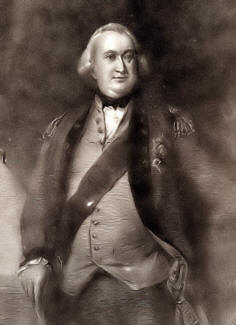 The news of the surrender of Cornwallis at Yorktown spread great joy
throughout the colonies, especially at Philadelphia, the seat of the
national government. Washington sent
Lieutenant-Colonel Tilghman to
Congress with the news. He rode express to Philadelphia to carry the
dispatches of the chief announcing the joyful event. He entered the
city at midnight, October 23, and knocked so violently at the door of
Thomas McKean, the president of Congress, that a watchman was
disposed to arrest him. Soon the glad tidings spread over the city.
The watchman, proclaiming the hour and giving the usual cry, "All's well,"
added, "and Cornwallis is taken!" Thousands of citizens rushed from
their beds, half dressed, and filled the streets. The old
State-house bell that had clearly proclaimed independence, now rang
out tones of gladness. Lights were seen moving in every house. The
first blush of morning was greeted with the booming of cannon, and
at an early hour the Congress assembled and with quick-beating
hearts heard Charles Thomson read the dispatch from Washington. At
its conclusion it was resolved to go in a body to the Lutheran
church, at 2 P.M., and "return thanks to the Almighty God for
crowning the allied armies of the United States and France with
success." A week later that body voted the thanks of the nation and
appropriate honors to Washington, Rochambeau, and De Grasse, and
their respective officers and men; and appointed a day for a general
thanksgiving and prayer throughout the Union on account of God's
signal favors to the struggling patriots. Everywhere legislative
bodies, executive. councils, city corporations. and private
societies presented congratulatory addresses to the commanding
generals and their officers. The Duke de Lauzun bore the glad
tidings of victory to the Court at Versailles. The news of the surrender of Cornwallis at Yorktown spread great joy
throughout the colonies, especially at Philadelphia, the seat of the
national government. Washington sent
Lieutenant-Colonel Tilghman to
Congress with the news. He rode express to Philadelphia to carry the
dispatches of the chief announcing the joyful event. He entered the
city at midnight, October 23, and knocked so violently at the door of
Thomas McKean, the president of Congress, that a watchman was
disposed to arrest him. Soon the glad tidings spread over the city.
The watchman, proclaiming the hour and giving the usual cry, "All's well,"
added, "and Cornwallis is taken!" Thousands of citizens rushed from
their beds, half dressed, and filled the streets. The old
State-house bell that had clearly proclaimed independence, now rang
out tones of gladness. Lights were seen moving in every house. The
first blush of morning was greeted with the booming of cannon, and
at an early hour the Congress assembled and with quick-beating
hearts heard Charles Thomson read the dispatch from Washington. At
its conclusion it was resolved to go in a body to the Lutheran
church, at 2 P.M., and "return thanks to the Almighty God for
crowning the allied armies of the United States and France with
success." A week later that body voted the thanks of the nation and
appropriate honors to Washington, Rochambeau, and De Grasse, and
their respective officers and men; and appointed a day for a general
thanksgiving and prayer throughout the Union on account of God's
signal favors to the struggling patriots. Everywhere legislative
bodies, executive. councils, city corporations. and private
societies presented congratulatory addresses to the commanding
generals and their officers. The Duke de Lauzun bore the glad
tidings of victory to the Court at Versailles. |


 The allies began the second parallel on the night of the 11th, which
the British did not discover until daylight came, when they brought
several heavy guns to bear upon the diggers. On the 14th it was
determined to storm two of the redoubts which were most annoying,
as they commanded the trenches. One on the right, near the York
River, was garrisoned by forty-five men; the other, on the left,
was manned by about 120 men. The capture of the former was entrusted
to Americans led by
The allies began the second parallel on the night of the 11th, which
the British did not discover until daylight came, when they brought
several heavy guns to bear upon the diggers. On the 14th it was
determined to storm two of the redoubts which were most annoying,
as they commanded the trenches. One on the right, near the York
River, was garrisoned by forty-five men; the other, on the left,
was manned by about 120 men. The capture of the former was entrusted
to Americans led by 
 The delivery of the colors of the several British regiments at
Yorktown, twenty-eight in number, was performed in this wise:
twenty-eight British captains, each bearing a flag in a case, were
drawn up in line. Opposite to these were twenty-eight American
sergeants in a line to receive them. Colonel Hamilton, who had the
direction of the movement, appointed an ensign to conduct the
ceremony. When that officer gave the order for the British captains
to advance two paces and deliver up their colors, and the American
sergeants to advance two paces to receive them, the former
hesitated, and gave as a reason that they were unwilling to
surrender their flags to noncommissioned officers. Hamilton, who
was at a distance, observed the hesitation, and rode up to inquire
the cause. On being informed, he willingly spared the feelings of
the vanquished captains, and ordered the ensign to receive them
himself and then deliver them to the sergeants.
The delivery of the colors of the several British regiments at
Yorktown, twenty-eight in number, was performed in this wise:
twenty-eight British captains, each bearing a flag in a case, were
drawn up in line. Opposite to these were twenty-eight American
sergeants in a line to receive them. Colonel Hamilton, who had the
direction of the movement, appointed an ensign to conduct the
ceremony. When that officer gave the order for the British captains
to advance two paces and deliver up their colors, and the American
sergeants to advance two paces to receive them, the former
hesitated, and gave as a reason that they were unwilling to
surrender their flags to noncommissioned officers. Hamilton, who
was at a distance, observed the hesitation, and rode up to inquire
the cause. On being informed, he willingly spared the feelings of
the vanquished captains, and ordered the ensign to receive them
himself and then deliver them to the sergeants. The news of the surrender of Cornwallis at Yorktown spread great joy
throughout the colonies, especially at Philadelphia, the seat of the
national government. Washington sent
The news of the surrender of Cornwallis at Yorktown spread great joy
throughout the colonies, especially at Philadelphia, the seat of the
national government. Washington sent